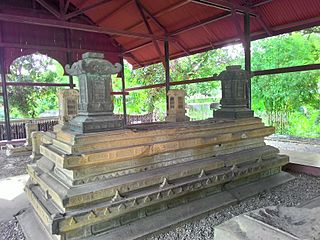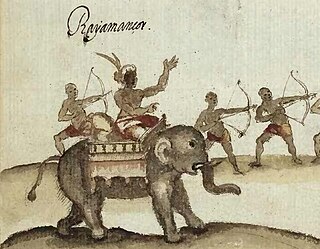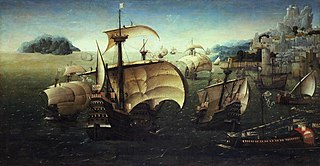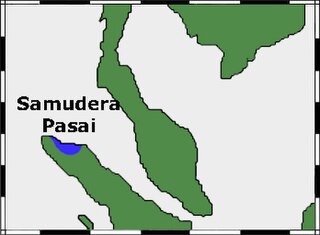
The Sultanate of Aceh, officially the Kingdom of Aceh Darussalam, was a sultanate centered in the modern-day Indonesian province of Aceh. It was a major regional power in the 16th and 17th centuries, before experiencing a long period of decline. Its capital was Kutaraja, the present-day Banda Aceh.
Sultan Alauddin Riayat Shah II ibni Almarhum Sultan Mahmud Shah was the first sultan of Johor. He ruled Johor from 1528 to 1564. He founded the Johor Sultanate following the fall of Malacca to the Portuguese in 1511. He was the second son of Mahmud Shah of Malacca. Thus, Johor was a successor state of Malacca and Johor's sultans follow the numbering system of Malacca. Throughout his reign, he faced constant threats from the Portuguese as well as the emerging Aceh Sultanate.

Ali Mughayat Syah was the first Sultan of Aceh Darussalam in Northern Sumatra, reigning from about 1514 until his death. His reign not only saw the foundation of the Aceh Sultanate, but also the conquest of neighboring Daya (1520), Pidie (1521), and Pasai (1524). Despite his accomplishments, Ali Mughayat's life is poorly documented and must be pieced together from various Acehnese, Malay and European accounts.
Salahuddin was the second Sultan of Aceh Darussalam, reigning from 1530 to either 1537 or 1539. He was the eldest son of Sultan Ali Mughayat Syah, the founder of the Aceh Sultanate. His reign was characterized by weakness, and he was deposed by his ambitious younger brother, Alauddin al-Kahar.

Alauddin Ri'ayat Syah al-Kahar was the third Sultan of the Aceh Sultanate, reigning from either 1537 or 1539 until his death. He is considered to be one of the strongest rulers in the history of the sultanate and greatly strengthened Aceh. Alauddin's reign was marked by increased conflict with his Portuguese and Malay rivals and his dispatching of envoys to the Ottoman sultan, Suleiman the Magnificent in the 1560s.

Iskandar Muda was the twelfth Sultan of Acèh Darussalam, under whom the sultanate achieved its greatest territorial extent, holding sway as the strongest power and wealthiest state in the western Indonesian archipelago and the Strait of Malacca. "Iskandar Muda" literally means "young Alexander," and his conquests were often compared to those of Alexander the Great. In addition to his notable conquests, during his reign, Aceh became known as an international centre of Islamic learning and trade. He was the last Sultan of Aceh who was a direct lineal male descendant of Ali Mughayat Syah, the founder of the Aceh Sultanate. Iskandar Muda's death meant that the founding dynasty of the Aceh Sultanate, the House of Meukuta Alam died out and was replaced by another dynasty.

Acehnese or Achinese is an Austronesian language natively spoken by the Acehnese people in Aceh, Sumatra, Indonesia. This language is also spoken by Acehnese descendants in some parts of Malaysia like Yan, in Kedah. Acehnese is used as the co-official language in the province of Aceh, Indonesia. Besides Indonesian used as the official language.

The Acehnese are an indigenous ethnic group from Aceh, Indonesia on the northernmost tip of the island of Sumatra. The area has a history of political struggle against the Dutch colonial rule. The vast majority of the Acehnese people are Muslims. The Acehnese people are also referred to by other names such as Lam Muri, Lambri, Akhir, Achin, Asji, A-tse and Atse. Their language, Acehnese, belongs to the Aceh–Chamic group of Malayo-Polynesian of the Austronesian language family.

Sultan Ali Ri'ayat Syah I, also known as Sultan Husein, was the fourth sultan of Aceh in northern Sumatra. He reigned from 1571 to 1579 and continued his father's policy of fighting the Portuguese in Melaka.

Sultan Alauddin Mansur Syah was the eighth Sultan of Aceh in northern Sumatra. He ruled Aceh from 1579 to 1585 or 1586 and was known as a pious Muslim ruler with cultural interests. His reign also saw some military expansion on the Malay Peninsula. With his death ended a 65-year long period of warfare between Aceh and the Portuguese.
Sultan Alauddin Ri'ayat Syah Sayyid al-Mukammal was the tenth Sultan of Aceh in northern Sumatra, ruling from 1589 to 1604. His reign is important since it saw the arrival of three new European powers to the region of the Melaka Straits: the Dutch, English and French.
Sultan Ali Ri'ayat Syah III was the eleventh Sulṭān of Acèh Darussalam in northern Sumatra. He had a brief and turbulent reign from 1604 to 1607 before being succeeded by his more famous nephew Iskandar Muda.
Sultan Alauddin Jauhar ul-Alam Syah was the twenty-ninth sultan of Aceh in northern Sumatra. He ruled in 1795–1815 and again in 1819–1823, the intervening period being filled by the usurper Syarif Saiful Alam Syah.

The War of the League of the Indies was a military conflict in which a pan-Asian alliance formed primarily by the Sultanate of Bijapur, the Sultanate of Ahmadnagar, the Kingdom of Calicut, and the Sultanate of Aceh, referred to by the Portuguese historian António Pinto Pereira as the "league of kings of India", "the confederated kings", or simply "the league", attempted to overturn Portuguese presence in the Indian Ocean. This was attempted through a combined assault on some of the main possessions of the Portuguese State of India: Malacca, Chaul, Chale fort, and the capital of the maritime empire in Asia, Goa.
The Aceh Expedition was a military expedition launched by the Portuguese against the Acehnese to force them to build a Portuguese fortress near Aceh. However, the expedition ended in failure.
The Acehnese launched their invasion of Johor between 1613 and 1615 to subjugate and vassalize the Johor Sultanate, as part of the Acehenese expansion in the Malay peninsula under Iskandar Muda reign.
The Pedir expedition was launched by the Portuguese in order to support the Sultanate of Pedir during the Acehnese invasion of the capital, the expedition ended in failure.

The Conquest of Pasai was a military campaign in 1523–1524 launched by the Sultanate of Aceh against the Samudera Pasai Sultanate and the Portuguese fortress there. The operation was a success for the Acehnese.
The Battle of Aceh was a 1528 military engagement between a lone Portuguese galley and an Acehnese armada near the coast of Aceh, located in present-day Indonesia. The Acehnese captured the Portuguese galley.

Acehnese–Portuguese conflicts were the military engagements between the forces of the Portuguese Empire, established at Malacca in the Malay Peninsula, and the Sultanate of Aceh, fought intermittently from 1519 to 1639 in Sumatra, the Malay Peninsula or the Strait of Malacca. The Portuguese supported, or were supported, by various Malay or Sumatran states who opposed Acehnese expansionism, while the Acehnese received support from the Ottoman Empire and the Dutch East India Company.












